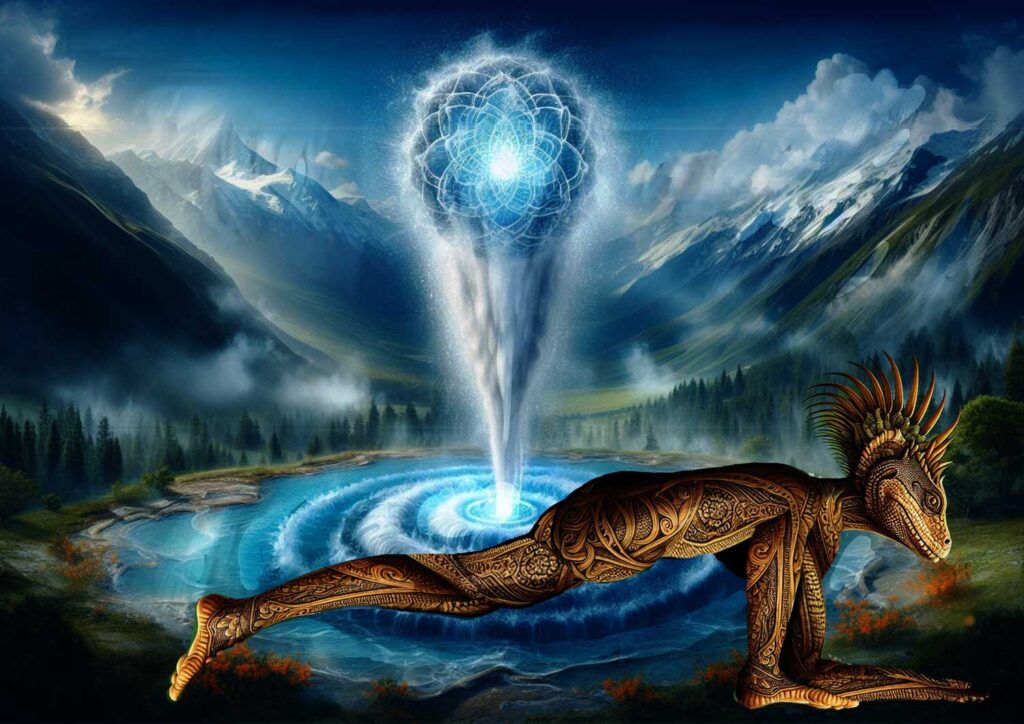Exploring the Myth of Vritra, the Sacral Chakra, and Lizard Pose in Yoga
The mythological story of Vritra—a dragon-like being who withheld the waters of the world—is a powerful metaphor for the flow of spiritual energy (prana) and consciousness. When Indra, the king of the gods, defeats Vritra, the waters are released, symbolizing the nourishment of the soul and the fostering of enlightenment and liberation (moksha). This ancient tale offers a fascinating lens through which to understand spiritual principles in yoga and energy work.
The Myth of Vritra: The Keeper of the Waters
In the primordial age, when the cosmos was still finding its rhythm, the demon Vritra rose to power, embodying drought, stagnation, and resistance to life’s natural flow. Vritra, a colossal Dragon-like being, coiled itself around the sacred rivers of the world, halting their life-giving waters. With the rivers imprisoned, the land withered, and the beings of the earth cried out in desperation.
The gods, powerless against Vritra’s immense strength, turned to Indra, the storm god and wielder of the thunderbolt (vajra), for salvation. Indra, armed with courage and divine purpose, embarked on a quest to confront the beast. A fierce battle ensued, shaking the heavens and the earth. With a mighty strike of his thunderbolt, Indra pierced Vritra’s armored scales, breaking the demon’s hold and unleashing the waters back into the world.
As the rivers surged forth, they revived the parched lands, bringing vitality and abundance to all living beings. This moment of release—the waters flowing freely once again—came to symbolize the triumph of life over stagnation, liberation over bondage, and renewal over decay. The myth of Vritra’s defeat carries profound lessons about overcoming internal obstacles and allowing the flow of energy, creativity, and emotions to resume in our own lives.

Vritra, Waters, and Release
In the Rigveda, Vritra’s hoarding of the waters represents a blockage of life’s vital forces, creating drought and stagnation. Indra’s triumph represents the removal of obstacles that block vitality and flow, leading to renewal and abundance. This narrative can be interpreted as an allegory for overcoming internal barriers, releasing pent-up energies, and allowing the natural rhythms of life to resume. The release of the waters mirrors the liberation of emotional, creative, and spiritual energy within the human experience.
The Sacral Chakra (Svadhishthana)
The sacral chakra, or Svadhishthana, is closely tied to the themes of water and flow in the body. Located in the pelvic region, about two inches below the navel, it is considered the energetic center for creativity, emotion, and sensuality. Its qualities and symbolism include:
- Location: The sacral chakra sits between the root chakra (base of the spine) and the solar plexus chakra (upper abdomen).
- Color: Its associated color is orange, often used in meditative or visualization practices.
- Element: Water is the sacral chakra’s governing element, reflecting adaptability, emotional depth, and the fluidity of life.
- Symbolism: Represented by a six-petaled lotus, it is linked to the moon, emphasizing its influence over emotional tides and cycles.
Key attributes of the sacral chakra include:
- Emotions: Governs emotional expression and stability.
- Creativity: Inspires artistic and imaginative pursuits.
- Sexuality: Central to sexual energy and relationships.
- Desire: Drives both physical pleasures and broader life goals.
- Relationships: Influences emotional connections and intimacy with others.
Blockages in the sacral chakra can lead to emotional instability, reduced creativity, and challenges in experiencing pleasure, paralleling the stagnation caused by Vritra’s withholding of the waters.
The Connection to Lizard Pose
Lizard Pose (Utthan Pristhasana) is a deep hip-opening yoga posture that engages the psoas muscles and stimulates the sacral chakra. This pose encourages the release of tension in the hips and groin, areas often linked to stored stress and unresolved emotions. The physical act of opening the hips parallels the symbolic release of blocked waters in the Vritra myth. By practicing Lizard Pose with mindfulness, one can:
- Release Emotional Energy: Free up suppressed feelings associated with the sacral chakra.
- Enhance Creativity: Open pathways for artistic and imaginative energy.
- Foster Emotional Balance: Promote a sense of stability and flow in life.
The psoas muscle, known as the “fight or flight” muscle, plays a key role in the body’s stress response. Tension stored in the psoas can create a sense of contraction and fear. Lizard Pose, by targeting this muscle, can help release these stored energies, fostering a sense of ease and adaptability.

Integrating Myth and Practice
By connecting the story of Vritra to the practice of Lizard Pose, yoga practitioners can deepen their experience by exploring both physical and symbolic dimensions. The pose becomes not just a physical stretch but a meditative act of releasing blockages and embracing the flow of life’s energy. Through this integration:
- The Vritra myth inspires reflection on personal obstacles and the importance of liberation.
- The sacral chakra framework adds a layer of energetic awareness, encouraging practitioners to explore their creative and emotional centers.
- The physical practice of Lizard Pose offers a tangible method for releasing tension and fostering renewal.
Conclusion
The myth of Vritra’s defeat, the symbolism of the sacral chakra, and the practice of Lizard Pose together create a rich tapestry for exploring transformation and flow. This synthesis invites practitioners to not only engage with their bodies but also embark on an introspective journey—liberating emotional blockages, enhancing creativity, and aligning with the rhythms of life. Through this practice, one can experience the profound interplay between myth, movement, and energy, unlocking new pathways for healing and growth.
